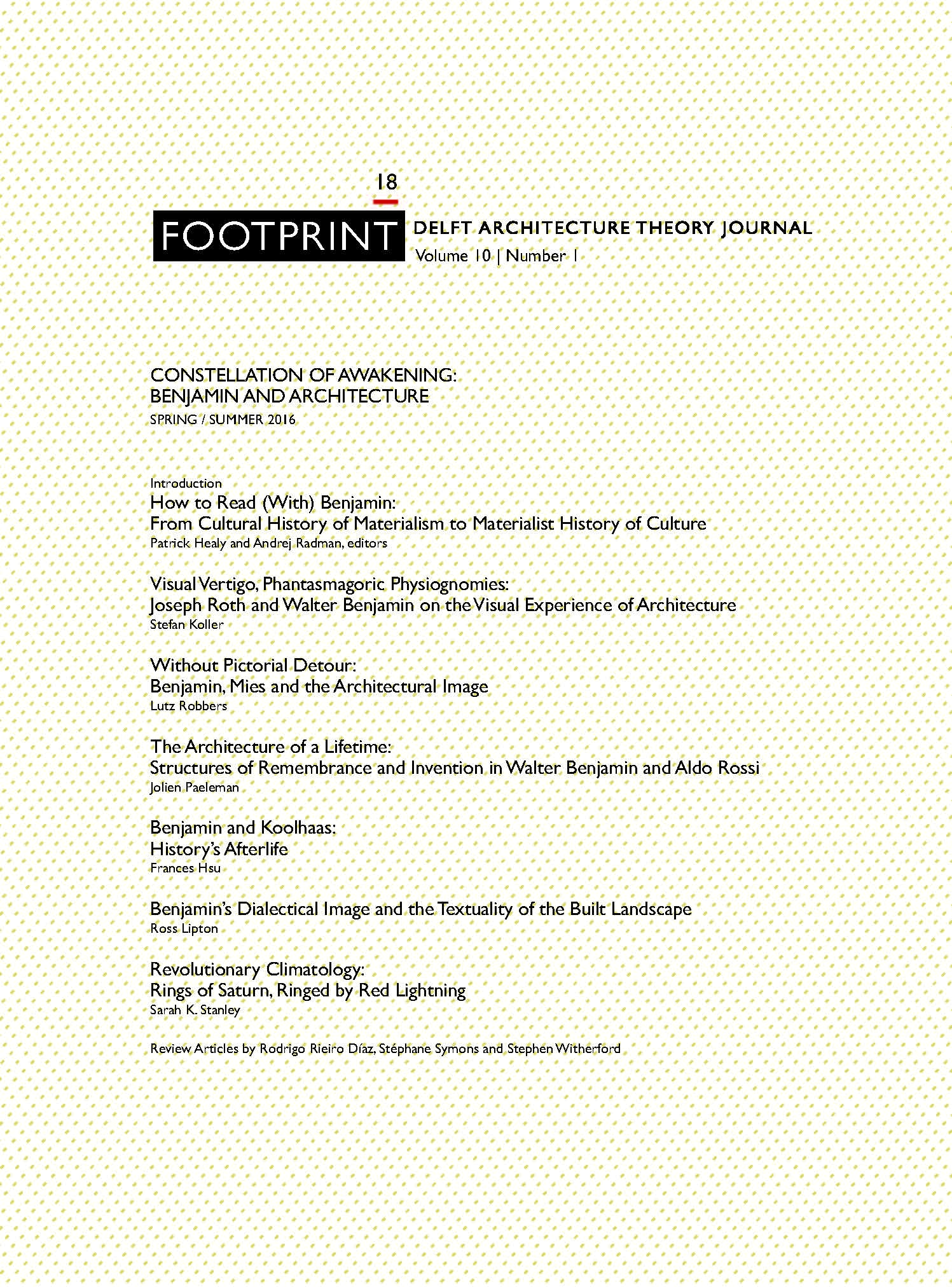The Architecture of a Lifetime: Structures of Remembrance and Invention in Walter Benjamin and Aldo Rossi
DOI:
https://doi.org/10.7480/footprint.10.1.970Abstract
This article presents the result of research on the influence of Walter Benjamin’s thinking in the work of Italian architect Aldo Rossi (1931–1997). In present-day architectural criticism, Aldo Rossi’s oeuvre still constitutes a rich subject for discussion because of its resistance to easy pinpointing, even if Rossi himself explained his theories and methods of design on numerous occasions. In his writings, among these A Scientific Autobiography, Rossi quotes from a collection of Benjamin’s memoirs: Berlin Childhood around 1900. The architect believes that these short prose pieces express better than anything else what he himself had not been able to explain in his writing. In this paper I intend to show the poignancy of the words Rossi referred to and the implications they had on his architecture by offering close comparisons of Benjamin’s and Rossi’s autobiographical writings. In addition, this study examines how one of Rossi’s most famous architectural artefacts, the ossuary of San Cataldo cemetery at Modena, can be viewed as a coalescence of a Benjaminian thought-image, thereby fortifying the philosopher’s presence in modern architecture.
References
Bekaert, Geert. “The analogue of a proletarian architecture. Notes for an article on Aldo Rossi.” In Rooted in the Real, edited by Christophe Van Gerrewey, 298-351. Ghent: WZW editions and productions, 2011.
Benjamin, Walter. One-Way Street and Other Writings. London/ New York: Verso, 1997 [1979].
Benjamin, Walter. Berlin Childhood around 1900. Cambridge (Mass.)/ London: Harvard University Press, 2006.
Brandolisio, Marco et al., ed. Aldo Rossi. Disegni 1990 – 1997, Milano: Federico Motta Editore, 1999.
Dal Co, Francesco, ed. I quaderni azzurri 1968-1992, Milan/ Los Angeles: Electa/ The Getty Research Institute, 1999.
Ferlenga, Alberto, ed. Aldo Rossi. Tutte le opere. Milano: Electa, 2003 [1999].
Frisby, David. Fragments of Modernity. Theories of Modernity in the Work of Simmel, Kracauer and Benjamin. Cambridge: Polity Press, 1985.
Havik, Klaske. Urban Literacy. A Scriptive Approach to the Experience, Use, and Imagination of Place. Rotterdam: nai010 publishers, 2014.
Özkaya, Belgin Turan. “Visuality and architectural history.” In Rethinking Architectural Historiography, edited by Dana Arnold et al., 183- 199. London/ New York: Routledge, 2006.
Poletti, Giovanni. L’Autobiografia scientifica di Aldo Rossi. Un’indagine tra scrittura e progetto di architettura. Milano/Torino: Bruno Mondadori, 2011.
Richter, Gerhard. Walter Benjamin and the Corpus of Autobiography, Detroit: Wayne University Press, 2000.
Richter, Gerhard. Thought-Images. Frankfurt School Writers’ Reflections from Damaged Life. Stanford (Ca.): Stanford University Press, 2007.
Rossi, Aldo. A Scientific Autobiography. Cambridge (Mass.): MIT press, 1981.
Rossi, Aldo. The Architecture of the City. Cambridge (Mass.): MIT press, 1982.
Rossi, Aldo. Scritti scelti sull’architettura e la città 1956 – 1972, Macerata: Quodlibet, 2012 [1975].
Sainz Gutiérrez, Victoriano. “Las distancias invisibles. Aldo Rossi y Walter Benjamin”, Thémata. Revista de Filosofía 41 (2009): 372 – 399.
Sainz Gutiérrez, Victoriano. “Rossi e Benjamin: Dall’ ‘esprit de système’ al montaggio di frammenti” in La lezione di Aldo Rossi edited by Annalisa Trentin, 98–105. Bologna: Bonomia University Press, 2008.
Severijnen, Olav. Individuum est ineffabile. De modernistische autobiografie tussen Goethe en Leiris. Amsterdam/ Atlanta: Rodopi, 1989.
Downloads
Published
Issue
Section
License
- Authors retain copyright and grant the journal right of first publication with the work simultaneously licensed under a Creative Commons Attribution License that allows others to share the work with an acknowledgement of the work's authorship and initial publication in this journal.
- Authors are able to enter into separate, additional contractual arrangements for the non-exclusive distribution of the journal's published version of the work (e.g., post it to an institutional repository or publish it in a book), with an acknowledgement of its initial publication in this journal.





